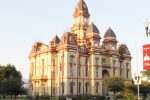More than just a walk around the block
Paul Farley
Subdeacon, St. Andrew Orthodox Church
If you’re passing by the courthouse square in the late morning on Sunday, March 24, don’t be surprised if you see a small group of people walking around the square carrying what look to be paintings. It’s simply parishioners of St Andrew the First-Called Orthodox Church carrying on a one-thousand-one-hundred-eighty-one-year-old tradition.
For those familiar with the Orthodox Church, perhaps its most distinctive outward characteristic is the use of icons — traditionally hand-painted, but these days with full-color laser printers, commonly on glossy photo-paper and, more often than not, mounted on a piece of wood. Churches, and parishioners’ homes, are typically filled with them. The use of icons dates back to apostolic times; indeed, the Holy Evangelist Luke is credited with painting the first ones.
At the beginning of the 6th century the historian Theodorus Lector (Anagnostes) recorded that the Empress Aelia Eudocia sent “the greatest relic,” an icon of the Virgin Mary by the Evangelist Luke, from Palestine to her sister Pulcheria, the wife of Emperor Marcian in Constantinople. In 1131, the icon was sent from Constantinople to Russia, where it was placed in the Devichi monastery in Vyshgorod. Today the icon, now known as “Our Lady of Vladimir,” resides in a church attached to the Tretyakov Art Gallery in Moscow.
Of course, Orthodox Christians don’t worship icons (there’s a commandment that has something to say about that); rather they are used to facilitate focus in prayer. Because of the Incarnation, it is of course possible to create an image of the Son of God. If Edison had been born a little more than 2,000 years ago, we would no doubt have thousands of photos of Jesus. But instead, people painted His image, using it to help constantly remind them of Who they were trying to follow.
If you’ve ever kept a photo of a loved one by your bed so you could see it first thing in the morning and last thing in the evening, you have an idea. You might even be so devoted as to kiss it occasionally, as the Orthodox do with icons. But you wouldn’t be worshipping the photo.
Even so, in the early 8th century, some Christians began to destroy icons and persecute those who venerated them; they became known as Iconoclasts (literally, “image destroyers”). Then the government got involved: for over a hundred years, various Byzantine emperors used state-sponsored violence to strip churches of images, and imprisoning, mutilating, and murdering those who continued to venerate (or even possess) icons. Finally, the last iconoclast emperor, Theophilos, died, and his wife Theodora summoned a church council hoping to bring peace.
In 843 A.D., on the first Sunday of Great Lent, the council decisively rejected the iconoclasts and declared that: “Whenever these representations are contemplated, they will cause those who look at them to commemorate and love their prototype. We define also that they should be kissed and that they are an object of veneration and honor, but not of real worship, which is reserved for Him Who is the subject of our faith and is proper for the divine nature.”
What followed was a triumphal procession, with people carrying long-hidden icons to the great church of Hagia Sophia in Constantinople. This historic event is known as the Restoration of the Holy Icons, the Triumph of Orthodoxy or, simply, the Sunday of Orthodoxy. It continues to be remembered by Orthodox churches throughout the world during Great Lent, typically with icon processions and hymns. Thus, although at first glance someone might mistake Sunday morning’s procession for some kind of protest, the Caldwell County Courthouse will in fact be the honored location of a celebration of religious liberty finally won more than 11 centuries ago.



